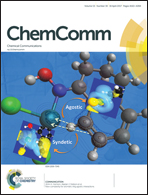Programmable self-assembly of water-soluble organo-heterometallic cages [M12M′4L12] using 3-(3,5-dimethyl-1H-pyrazol-4-yl)pentane-2,4-dione (H2L)†
Abstract
A bifunctional ligand H2L featuring primary (pyrazole) and secondary (acetylacetone) coordination sites was preferentially reacted with dimetallic [M2(NO3)2](NO3)2 linkers at the pyrazolyl end of H2L, giving rise to dimetallic corners. Subsequently, the corners serve as the secondary site with M′ to form water-soluble organo-heterometallic [M12M′4L12] cages in a stepwise mode.
![Graphical abstract: Programmable self-assembly of water-soluble organo-heterometallic cages [M12M′4L12] using 3-(3,5-dimethyl-1H-pyrazol-4-yl)pentane-2,4-dione (H2L)](/en/Image/Get?imageInfo.ImageType=GA&imageInfo.ImageIdentifier.ManuscriptID=C7CC00425G&imageInfo.ImageIdentifier.Year=2017)


 Please wait while we load your content...
Please wait while we load your content...